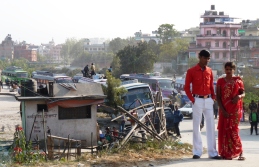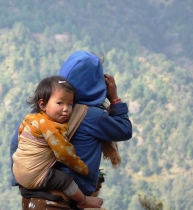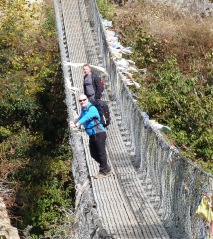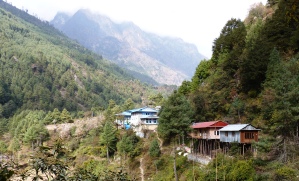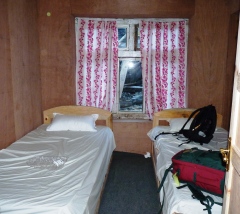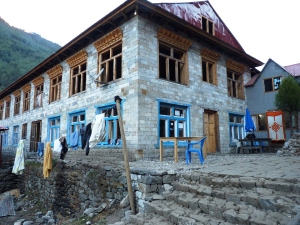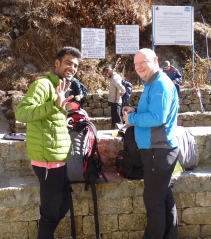13th November 2012
So after a day of acclimatisation, it was time to push on. The destination for the day was Tengboche.
“We are up at 6.30am. We pack and I have a breakfast of cheese and tomato omelette. The lodge in Namche has been great and I suspect the accommodation may go downhill from here.”
 ” There is snow all around as we head off. We saw most of today’s route when we were at the Everest View Hotel yesterday, so we’ve got a pretty good idea what to expect. We start by following the contours, so given it was relatively flat, I persuaded Dan to stay with us for a bit.”
” There is snow all around as we head off. We saw most of today’s route when we were at the Everest View Hotel yesterday, so we’ve got a pretty good idea what to expect. We start by following the contours, so given it was relatively flat, I persuaded Dan to stay with us for a bit.”
“We meet an old fellow along the route, who, for the last 20 or 30 years has got up early to collect money for the upkeep of a Buddhist shrine situated on one of the bends. Who knows how old he is? Maybe 80? He has also built (single-handedly) a beautiful set of stone steps leading up to the shrine. We give him 1,500 rupees and his face and his milky eyes light up. We receive a very deep bow, which we return. A real character of the mountains – with, I suspect, a million stories.”
“After a couple of miles, the path starts dropping down towards the river. This is always disheartening, when you know that your destination is higher up! I haven’t been feeling 100% today, but it’s heard to put my finger on what’s not right. I have a slight, dull headache and feel slightly nauseous. Is this the start of altitude sickness?”
“I was very glad of my new, red poles as we start the big climb up from the bridge. It is slow, hard work, punctuated by stops to let cows and yaks (yes, my first encounter with the fabled yaks!) get past. The yaks look like very stocky, long-haired cows. They have a look that gives you the strong impression they are not to be meddled with.”
Prakash always fussed about me when these caravans are approaching – particularly the cows and yaks. He would find me a suitable, mountain-side-of-the-path spot to shelter in and usher me into it. Apparently, the animals are pretty temperamental and you really don’t want to be the wrong side of the path, for fear of being pushed over the edge.
“We finally reach the top of the climb (it’s been a vertical gain of about 600m – similar to the climb up into Namche) right outside the hotel. I say hotel, because that’s what it’s called – the Himalayan Hotel. but it’s basically a lodge with 2 stories. We arrive at 12.50pm, exactly 5 hours
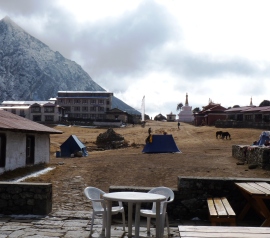
Tengboche, from the bakery
after leaving Namche and pretty much average for trekkers. Dan had arrived at 10.30am. Prakash had never heard of anyone doing it in that time.”
“I feel a light lunch is appropriate, as I’m still not feeling great. So I have a bowl of chicken soup. We go up to our room which looks directly down the valley towards Everest. Quite a view!”
“Having been blisteringly sunny all day, it begins to cloud over. We wander down to the Tengboche bakery and put away some apple crumble pie, which is very welcome. At 3pm, the daily Buddhist ceremony starts in the monastery, so we poke our nose in. The ceremonial room is fantastically ornate, with a 5m high statue of Buddha at the front. The ceremony, to our uninitiated eyes, seems to consist of alternating tea-drinking with chanting.”
“Dan has admitted defeat with my snoring and puts forward the suggestion of separate rooms. To be honest, I would get a better night’s sleep on my own too. So we enquire and they have a spare room. The price for the night – 200 rupees (about £1.50!). Dan nearly bites the girl’s arm off!!”
The pricing of everything in the mountain takes a bit of getting used to. The lodges effectively give free rooms (based on 2 sharing) IF you eat at the lodge. And, unsurprisingly, the price of food and drink edges up with altitude.
“I manage a plateful of macaroni cheese (it’s just not the same with yak cheese!) and we have a lovely chat with a Polish married couple who are both lawyers. They are on their way down, but had only got as far as Loboche, before the woman had got a panic attack about not being able to breath. They were clearly a bit disappointed, but it was the right decision for them.”
“We also have a chat with one of the other guides about the political situation in Nepal. It appears that they had a king who everybody liked, who was ousted by his brother. Maoists then took over and the government now is a bit of a mess. I must look into it more when I get home.”
It ended up being a bit of a late one, as they ushered us out of the dining room – gone 9pm!
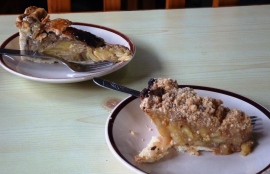
Pie from Tengboche bakery

The entrance to Tengboche monastery


